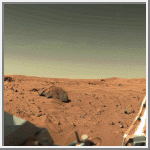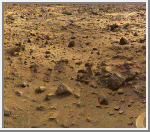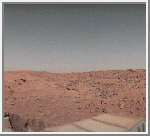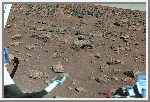
The Surface of Mars

The Surface of Mars

I am starting to put a page together on the surface of Mars. Right now it only includes some of the Viking Lander photographs which I have processed, and which NASA and JPL have processed. More will come with time.

 Lander 1 Site
(GIF, 391K;
JPEG, 291K)
Lander 1 Site
(GIF, 391K;
JPEG, 291K)
Big Joe, the large rock just left of center is about 2 meters (7 feet)
wide. The top of the rock is covered with red soil. The exposed portions of
the rock are similar in color to basaltic rocks on Earth. This rock may
be a fragment of a lava flow that was later ejected by an impact crater.
The red color of the rocks and soil is due to oxidized iron in the
eroded material. In some areas of this scene rocky plains tend to
dominate, while a short distance away drifts of
regolith have formed.
(Courtesy NASA/JPL)
 Lander 2 Site
(GIF, 727K;
JPEG, 610K)
Lander 2 Site
(GIF, 727K;
JPEG, 610K)
Viking Lander 2 used its sampler arm to
dig these two trenches in the regolith.
The shroud that protected the soil collector head during the lander's
descent lies a short distance away. The lander's footpad is visible in
the lower right corner of the image. The rounded rock in the center
foreground is about 20 centimeters (8 inches) wide, while the angular
rock farther back and to the right is about 1.5 meters (5 feet) across.
The gently sloping troughs between the artificial trenches and the angular
rock, which cut from the middle left to the lower right corner, are
natural surface features.
(Courtesy NASA/JPL)
 View From Lander 1
(GIF, 337K;
JPEG, 99K)
View From Lander 1
(GIF, 337K;
JPEG, 99K)
The Viking Lander 1 site in Chryse Planitia is a barren desert with
rocks strewn between sand dunes. The lander's footpad is visible at
lower right; a trench in the foreground (just below center) was dug by the
sampler arm. Patches of drift material and possibly bedrock are
visible farther from the Lander.
(Courtesy NASA/JPL)
 View From Lander 2
(JPEG, 517K)
View From Lander 2
(JPEG, 517K)
The Viking Lander 2 site in Utopia Planitia has more and larger blocks
of stone than does the Viking Lander 1 site in Chryse Planitia. The
stones are probably ejecta
from impact craters near the Lander 2 site.
Many of the rocks are angular and are thought to be only slightly altered
by the action of wind and other forms of erosion. Drifts of sand and dust
are smaller and less noticeable at the Lander 2 site. The overall red
coloring of the Martian terrain is due to the presence of oxidized iron
in the regolith. The pink color of the sky is caused by extremely fine
red dust that is suspended in Mars' thin atmosphere.
(Courtesy NASA/JPL)
 Frost at the Viking 2 Lander
(GIF, local 260K)
Frost at the Viking 2 Lander
(GIF, local 260K)
Viking Lander 2 is far enough north that frost deposits form on the
surface during winter. This image, taken in May 1979, shows a thin,
white layer of water frost, estimated to be only microns thick,
covering parts of the surface. The reddish regions are soil and rock
not covered by the frost. Portions of the spacecraft are visible in the
right foreground.
(Courtesy NASA/LPI)
 Viking Lander 1
(GIF, 1M;
JPEG, 219K;
TIF, 4M)
Viking Lander 1
(GIF, 1M;
JPEG, 219K;
TIF, 4M)
This is a color composite of Viking Lander images 12d089.red, 12d088.grn, and
12d087.blu.
(Copyright Calvin J. Hamilton)
 Viking Lander 1
(GIF, 300K;
JPEG, 13K;
TIF, 755K)
Viking Lander 1
(GIF, 300K;
JPEG, 13K;
TIF, 755K)
This is a color composite of Viking Lander images 12f010.red, 12f010.grn, and
12f010.blu.
(Copyright Calvin J. Hamilton)
 Viking Lander 1
(GIF, 122K;
JPEG, 17K;
TIF, 224K)
Viking Lander 1
(GIF, 122K;
JPEG, 17K;
TIF, 224K)
This is a color composite of Viking Lander images 12h051.red, 12h051.grn, and
12h051.blu.
(Copyright Calvin J. Hamilton)
 Viking Lander 2
(GIF, 261;
JPEG, 54K;
TIF, 1M)
Viking Lander 2
(GIF, 261;
JPEG, 54K;
TIF, 1M)
This is a color composite of Viking Lander images 21a082.red, 21a082.grn, and
21a082.blu.
(Copyright Calvin J. Hamilton)
 Viking Lander 2
(GIF, 245K;
JPEG, 41K;
TIF, 1M)
Viking Lander 2
(GIF, 245K;
JPEG, 41K;
TIF, 1M)
This is a color composite of Viking Lander images 21d049.red, 21d049.grn, and
21d049.blu.
(Copyright Calvin J. Hamilton)

